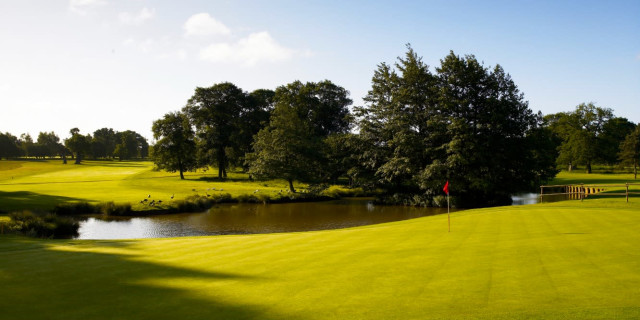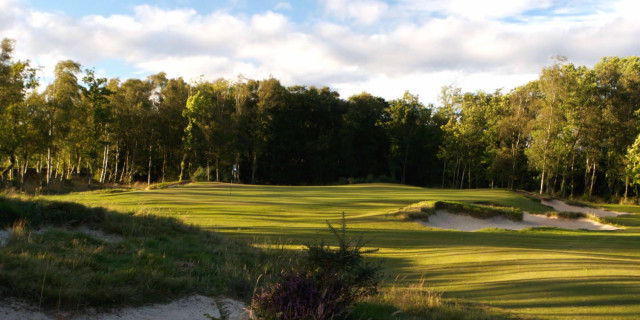Royal Portrush Feature Review
Golfshake Ambassador Andrew Picken recently experienced the Causeway Tour in Northern Ireland, discovering many of the regional links that will be showcased when the Open Championship returns to Royal Portrush in 2019. Here is Andy's review of the revered and historic venue.
Personal Introduction
When I knew that I was to be playing at Royal Portrush, I was nervous and excited in equal measure. One of my golfing heroes, my late father in law Joe Colbert, waxed lyrical whenever he spoke of the course and its surroundings. He had never played the layout but had walked it several times and we always said that we would take on its challenge together. He was the reason I first took up this wonderful game. My first clubs were his cast offs and he was the catalyst for my addiction became so firmly rooted.
Joe talked of Royal Portush in hushed, reverential tones and was anticipating its return to the Open rota years before it was confirmed. He loved this part of Ireland and he spoke several times of taking the family to the Causeway. This was his code for actually meaning to get to play at Royal Portrush. Unfortunately he contracted vascular dementia after a sudden stroke and all our plans and plotting failed.
He had played all over the globe but never got to tee it up at Royal Portrush. As I prepared for my trip to Belfast I knew that I would have to find a way of commemorating him as I played the hallowed turf. I packed some of his golf balls into my bag as a good luck charm. I still have his clubs and bags and even with the passage of time cannot bring myself to pass them on or give them away.
At the end his dementia meant that he was unable to recognise close family or friends but he never lost his love and affection for the game of golf.
As my time to tee it up at Royal Portrush came closer I hatched a plan to use his golf balls as a tribute to him and his desire to play this wonderful links that meant so much to him. The balls I was to use were ancient Spalding’s and the passage of time had turned them into small, hard rocks.
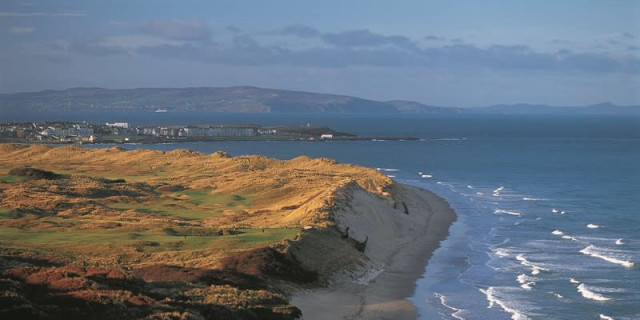
As I stood waiting to be called to the tee I could feel myself becoming overwhelmed and emotional. I decided to play safe and take a hybrid for accuracy given the out of bounds that lurks right and left off the tee on the first hole.
I struck the ball hard, and blocked it rightly directly out of bounds. I could barely see the ball as my vision was clouded by the warm tears that had begun to fall. I gathered myself and then played the provisional shot with exactly the same result. I looked to the heavens realising that I had put myself under immense pressure and let out an enormous belly laugh. I then realised that Joe was still with me and that he would be laughing his socks off at my futile attempts to play golf.
I walked away so that I didn’t delay my playing partners and wandered towards the balls that had sailed towards the OOB. I discovered that my first had in fact ricocheted back into play and was sitting a few yards in bounds. I gave it a crack and the round began.
I think that Calamity Corner; the par 3, 236 yards 16th will play an important part in the winning of the event. This is a stunning, wonderful golf hole, which I failed to finish having launched one of Joe’s Spalding rocks towards the green only to see it fly right into a barren area with rough of deep and unforgiving nature. I made no attempt to retrieve the ball thinking that it was completely appropriate for me to leave this ball behind as a simple tribute to my golfing hero.
20 Must Play Golf Courses in Northern Ireland
If you are visiting The Open this year and you find an old scuffed Spalding with the American Airlines logo on it, please leave it behind. However, I somehow think that where I put it, it is unlikely to ever see the light of day again.
Location and Club
Situated on the beautiful North Antrim Causeway coast, Royal Portrush Golf Club occupies a triangle of giant sand hills which present stunning views in all directions. he hills of Donegal are in the west, the Isle of Islay and Southern Hebrides in the north, with the Giant’s Causeway and the “Skerries” in the east. Skerries are a group of rock islands in the sea near to the coast.
The course is overlooked by the ruins of 13th century Dunluce Castle giving its name to the Championship Dunluce Course.
Playing Royal Portush was a lifetime ambition fulfilled. Sometimes it is difficult meeting a boyhood hero as they never quite meet your expectations. In this case they were exceeded!
This is simply one of the most iconic, challenging and yet most pleasurable rounds of golf that I have ever enjoyed. I didn’t play particularly well but that didn’t matter. We were blessed with a number of positive factors including a soft and warm autumn day. Fantastic company added to the mix. Having begun the round through tear fogged eyes and a blob, it could only get better. It did, and how.

The professional shop is exactly what you would expect for a venue of this global standing. They are already doing a roaring trade in Open memorabilia, months away from the event.
The clubhouse is packed with golfing memorabilia through the ages and given my recent preoccupation with war memorials at golf courses I was fascinated to see one given pride of place in the foyer of the clubhouse.
The silverware is stunning and provides a directory of Irish golfing greats through the ages. The food and beverages were superb and perfect fayre for the hungry golfer. No pretensions here of nouveaux cuisine. Simply great ingredients, food and service.
History
The original golf course was formed in May 1888, known as the County Club. It became known as the Royal County Club in 1892 when HRH the Duke of York became its patron. Three years later it was renamed Royal Portrush Golf Club with the Prince of Wales as its patron.
The inaugural Irish Open Amateur Championship was held here in 1892 along with the Irish professional championship in 1907, among over 60 national championships that have been played at this venue. It was originally a nine hole course extended to 18 holes by the famous architect Harry Colt. It was named the Dunluce Links in 1929.
Further architectural works were conducted by the professional PG Stevenson and Sir Anthony Babington just after the Second World War in 1947. Colt's original 1st and 18th holes had been eroded into the sea.
Hole by Hole Guide and Review
1st, "Hughies", Par 4, 416 Yards
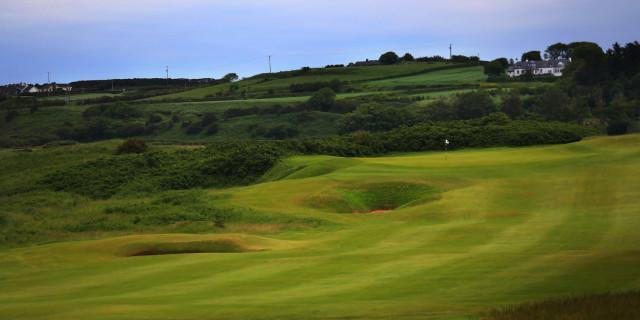
Although this looks an accommodating tee shot out of bounds looms left and right. Bunkers feature to the right and left of the fairway area and I can see many people using the strategy of using a long iron or a short hybrid for safety off the tee. it’s quite deceptive from the tee as it appears to be much more open than it actually is. Approach shots into the green are protected by runs and swales and by bunkers short and left. This is lovely opening hole as all the trouble is visible and in play. It is not a steady introduction to the course.
2nd, "Giants Grave”, Par 5, 572 Yards
Out of bounds lurks to the right for the majority of this hole. It is additionally protected by a trio of bunkers at the elbow of the dog-leg. Any shot pulled left to avoid these traps is likely to head towards another strategically placed bunker to the left of the fairway. This is a hole that dog legs right-to-left. Placement of a lay-up shot for the second is also made difficult by a series of swales and hollows and another trio of bunkers 60 yards short of the green.The green complex here is phenomenal. It really is quite distracting to be faced with the panoramic views and trying to assess the runs on this particular green. It is an absolute beauty.
3rd, “Islay”, Par 3, 174 Yards
There are no options to lay-up as the hole faces directly towards the Atlantic Ocean. There is a tee, there is a green, and nothing in-between. The best advice I can give here is that this needs to be a fully committed shot. Everything tends to break in from the right-hand side of the green which is why the bunker placed visibly and intimidatingly to the left and short of the green is exceedingly well-placed. This is another stunning golf hole with all the trouble visible and intimidating.
4th, “Fred Daly’s”, Par 4, 479 Yards
I actually believe that this is a par four and half. I would accept a five on this hole at my level of golf any day of the week. I hit a decent drive to the right of the largest of the bunkers that are visible from the tee providing myself with an opportunity of an accessible shot into the green. To the right of this fairway running the entire length of the hole is out of bounds, with a footpath and roadway.
To the right of which is a beautiful bungalow that was actually owned by Fred Daly, former caddie, club professional and Open champion.The green area is protected by two dunes that are short right and left. They provide a very intimidating visual entry into the green which falls away from you, making it even more difficult. This is another absolutely stunning golf hole.
5th, “White Rocks”, Par 4, 382 Yards

I consider to be one of the best risk or reward golf holes that I've ever played. This is a dog-leg left to right set at an angle of probably 45° from the elbow of the dog-leg. However, everything to the right of the fairway is rough and bracken and brambles.The key to playing this hole well is to commit to the shot. Anything short will be put into considerable difficulty due to the land and the covering of rough.
The second shot brings the water hazard into play. This is known as the Atlantic Ocean. Any shot long will career from the clifftops onto the beach and ocean below. The green is protected left and right by bunkers. The placement of these bunkers is just perfect as it encourages the full blooded shot bringing the ocean into play at the rear of the green.
This is all about risk and reward. How much of the corner can you take off and how confident are you that you will find the cut grass on the fairway. If you're not on the cut grass you're not realistically going to achieve par.
6th, “Harry Colt’s”, Par 3, 189 Yards

Striking the tee shot directly towards the ocean brings in to play all the wind and weather. The green is so beautifully natural that it has to be carefully sought out from the tee. The ground on this hole simply folds and furrows like a ruffled bed sheet. It is gloriously simple but wonderfully complex.
7th, “Curran Point”, Par 5, 590 Yards
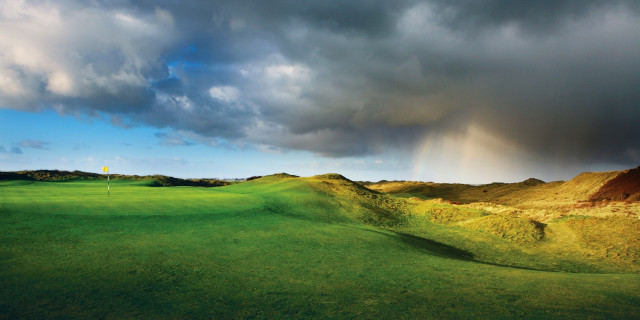
The initial tee shot is taken with a line towards a large bunker that is visually prominent and intimidating to the right hand side of the fairway. A shot drawn off this bunker will remain on the cut grass and will then provide an opportunity for an aggressive second shot. I could not consider this bold approach and had real difficulty finding a decent lay-up area to aim towards.
The hole meanders right and left along its length. It is not quite a dog-leg but at each lay-up the fairway pinches to reduce the easy option. I recognised that I needed to be able to use a lofted iron into a difficult and inaccessible green that is well protected by bunkers short and right and by its own natural topography. This is a wonderfully natural fairway that is shaped following the natural contours of the dune.
8th,“Dunluce”, Par 4, 430 Yards
The tee shot requires commitment to the right hand side of the fairway from the tee, anything left will be in gorse, bracken and rough that will swallow and then devour a golf ball.The safe line from the tee box is to aim to the right of the bunkers that protect the elbow of the dog-leg on the opposing side of the fairway. Anything blocked or pulled will be in trouble. The placement of the tee is very clever giving a whole host of options requiring shots played over rough and bracken. The red tees are 116 yards in front of the blue, with the visual perspectives from these different tees being excellent and all require a different golfing skill.The bunkers come into play for whatever level of golfer that is playing. In my humble opinion this is exceptionally designed to accommodate such a range of golfing skills within the same basic design elements. It is visually distracting as well as the views are superb across the course at this point.
9th, “Tavern”, Par 4, 431 Yards
The tee shot needs to be shaped left off the first bunker that sits on the right side of the fairway. Again the tee positioning is clever as it encourages shots away from the logical line. To the right of the tee boxes are some high shouldered dunes supported by deep, dark rough. The target line is left of the fairway bunker positioned to the right of the fairway. A draw off the bunker would be the ideal shot to give a chance of a reasonable approach into the green complex that can only be described as ‘rolling’ given the number of swales and runs as part of its defence. Add in a couple of deep pot bunkers and this becomes a challenging hole.
The bunkers are prominent but they have very tight turf around them so their actual footprint is considerably larger than they look visually prior to the shot. The greens again are protected short and left by bunkers but then the greens pace and structure offer additional challenges.
10th, “Himalayas”, Par 4, 456 Yards

This is a sweeping dog-left to right that almost follows a crescent shape. I took a driver which was played ineptly and left me in a lunar landscape to the right of the shoulder of the dog-leg with impossible shots into the green. Consulting the course guide after the event is never a good idea but the advice of a long iron or short wood is clearly excellent strategy for this hole.
The green itself is not protected by bunkers as it doesn't need any. It is protected by the weather and the dunes Its inane protection is the shape of the ground upon which it has been formed. There are stunningly beautiful views over towards the ocean. We played the course on a balmy autumn day. If the wind gets up this will be an incredibly difficult golf hole to play, even at professional level.
11th, “P.G. Stevenson’s”, Par 5, 475 Yards
From the championship tee it is a decent drive over the shoulder over the dog-leg. A carry of 260 yards is required to clear the rough to the right. A well struck drive following the shape of the hole that is laid out in front of the player from the tee box is required. If accomplished this will then bring up an approach that will allow both visual and playing access to an elevated green.
Anything short will be caught by the swales and runs and will be brought back towards the player. There is a lurking pot bunker short and left that's partially concealed. This is a beautiful example of natural bunkering and it could easily be missed if you had not played the course before.
12th, “Dhu Varren”, Par 5, 530 Yards
Dhu Varren is the name of an old railway holt that used to the service the town. It literally means “Blackberries”. A line of bunkers feature right of the fairway at the shoulder of the dog-leg to the left. The ideal line from the tee is to aim at the bunkers but draw the ball back into the fairway following the shape of the natural ground.
Anything pulled badly left will be gathered into the rough on ground that has a miriad of slopes and runs. Royal Portrush is difficult enough if you were playing from the fairway and it becomes very, very difficult to play from elsewhere other than the pristine turf. This hole plays back towards the town. It requires precision and care to effect a decent score. The green is protected by nature and the weather.
13th, “Feather Bed”, Par 3, 191 Yards
This is a green that is protected by a series of bunkers. The surrounds for the bunkers are closely cropped so they have greater footprint than is first obvious from the tee box. The green is elevated and tends to break from front right to back left on the green. Par here is an achievement.
14th, “Causeway”, Par 4, 470 Yards
This is a relatively straight hole policed by a series of bunkers to the right and left of the main fairway. Avoid these bunkers with the tee shot but then be mindful of the enormous bunker to the left of the green. The shoulder of this bunker rises higher above any golfer unfortunate enough to find it. The green itself is 38 yards front to back with a host of swales and runs built into it. This bunker is an absolute beauty and 50% of our playing group found it! The recovery shot requires a vertical shot played with spin for it to hold the green due to the gradients that carry the ball away for the flag.
If I was spectating at The Open I would seek to have view of this green as it will provide a challenge to event the best golfers in the world.
15th, “Skerries”, Par 4, 418 Yards
The skerries are a series of rocks in the sea that are visible form the beach. This is a clever layout as the championship tee makes this a severe dog-leg requiring precision play. The white tee box provides a straight line to the fairway over mild rough. Again three bunkers are situated to the right of the fairway that provide an intimidation factor to the golfer on the tee. The easiest approach to the green is made form the right hand side of the fairway so this will require clear placement and strategy.
This hole heads towards the sea and any wind from the Atlantic will affect it considerably. The green itself is long and thin protected short and left by deep pot bunkers. The suggestion in the course guide is to try and drive up the right hand side of the fairway for the best view of the green however this is exactly why the three bunkers have been placed to the right of that fairway. This is a classic golf hole.
16th, “Calamity Corner”, Par 3, 236 Yards
This is one of the most famous holes in golf. Standing on this tee box is a memorable experience. I've spoken elsewhere about the results of my efforts but this is a phenomenal golf hole.
The view from the 17th tee looking back across the course and over the ocean is truly wonderful. My photographs don’t really do this hole justice as there are so many factors that influence the shot. It is scary aiming at such a small target area that is subject to the vagaries of the weather. Anything right is gone forever given the depth and coarseness of the rough. I defy any golfer of any standard not to be intimidated by this shot.
17th, “Purgatory”, Par 4, 405 Yards
There is very clever use of the rough and dunes from the tee to maximise the intimidation factor afforded this hole for the initial tee shot. This is the same whatever tee box is in play. There are areas of rough and dune shoulders that impact severely on the views from the tee. A carry is required from all tee boxes to avoid these. However this automatically brings into play the cleverly shaped fairways that seem to channel any shots towards the hazards that wait to gobble up any errant golf balls. The aiming point for the approach shot is guided by a larger black and white pole at its rear. The green has more rollercoasters slopes than the Blackpool Pleasure Beach.
18th, “Babingtons”, Par 4, 473 Yards
This is a fine finishing hole. Bunkers and rough are visually intimidating down the right side of this hole but don’t let that hide the hazards that loom large down the left side. Anything over struck will be drawn towards the out of bounds that runs left for the half the hole from the green.
My experience was that the rough in this area is basically unplayable. This tee shot, under pressure, is likely to cause consternation during the course of the 2019 Open. I also expect the bunker short right of this green to attract lots of attention.
Overall Assesment
The 2017 amendments to the layout feel like they have been ever present. This is a sign of the excellence of this developmental work by the designer Martin Ebert. They fit beautifully into the existing layout and only add value to what is already a world leading golf course.
Despite its global standing this club has a wonderfully welcoming feel to any golfers lucky enough to visit. The trophy cabinets and memorabilia are stunning, so please give yourself time to review them when you visit. I would make the same recommendation in respect of the food and beverages.
This was a memorable golfing experience that I wholly recommend to anyone who plays this game.

Having spoken to the club secretary, Wilma Erskine, I am pleased to be able to confirm that any holder of a current Golfshake handicap would be entitled to play the facility if they are able to demonstrate the requisite skill level and knowledge of etiquette.The website usually asks for proof of handicap and a letter of introduction from your home club.
As Wilma said during her conversation with me about this point; “We like to be friendly here at Royal Portrush”. I could not possibly disagree. At all levels of the club from the shop to the clubhouse to the executive, our group was made to feel like we were members of this wonderful facility for the day. It was nothing short of superb.
For the next few months play will be restricted to using fairway mats with a period of understandable closure before The Open. Check the website for full details. I am already planning a return visit for late 2019 as this is a magnificent venue for the visiting golfer.
Related Content: Royal Portrush Northern Ireland Ireland
What do you think? post your thoughts and feedback on the Golfshake Forum: https://forum.golfshake.com/

